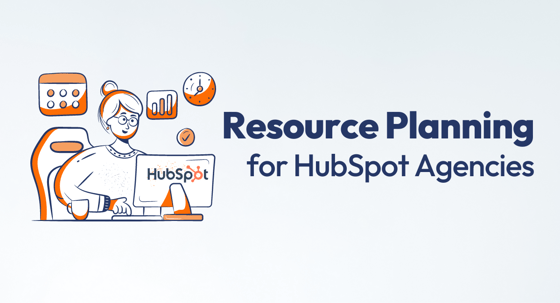Share this
How Successful HubSpot Agencies Do Resource Planning
by Juliette Lagerweij on April 17, 2024

“Plans are of little importance, but planning is essential.”
-Winston Churchill
Once your HubSpot deal is closed/won– if you’re efficient, even before that– the project officially gets underway. It’s time to start your planning.
One of the most important parts of the project planning process is lining up all your resources. You’ll need to figure out just how much time team members have to work on deliverables.
Resource planning is the process of determining who will be working on the next project and in what capacity.
Speaking of capacity, comprehensive resource planning will include capacity planning. This exercise helps you figure out how to schedule work in a way that efficiently utilizes each person’s time while keeping the project on time and within the budget
Resource planning isn’t necessarily complicated, but it can be tedious, especially if you have a large team or a complicated project.
HubSpot teams who want to do resource planning won’t be able to do it within Projects, HubSpot’s native project management tool, but there are practical ways to improve your resource planning with the rich store of data in your CRM.
Check out how successful HubSpot agencies do resource planning and how you can improve your resource planning process.
What is resource planning?
Resource planning refers to the process of identifying and scheduling all the resources necessary to complete a project.
Human resources as well as financial, material, and technological resources are all included under the resource planning umbrella.
Resource planning combines three disciplines, or processes: project planning, capacity planning, and resource management.
Resource Planning = Project Planning + Capacity Planning + Resource Management
In plain terms, resource planning helps you figure out who you’ll be relying on to get the job done, any other resources and capital needed to complete the project, and what all that is expected to cost.
Although you may begin resource planning sometimes even before the deal is closed, the process will extend throughout the entire lifecycle of the project.
For example, you may need to shift work around if team members find themselves beyond their capacity. Or you may need to onboard a new resource in the middle of the project to address an unexpected problem.
So, you can sit down and do your resource planning nicely and neatly during your project planning, but no matter what, you will return to this process again and again to manage the health of your project.
Why resource planning matters for project management
Don’t get caught in a lurch! Taking the time to plan your resources is worth the effort. Without effective resource planning, you can easily fall victim to overservicing, aka spending too much unbilled time on a project.
Or worse, you could fail to meet a deadline and lose a customer forever.
That’s why resource planning is such an integral process in project management. This is where you allocate work across the team based on their skills, knowledge, and experience.
Effective resource planning bears many fruits for project managers, as it can empower them to stay in control of their projects. As we mentioned earlier, it’s not a stagnant phase of the project, but rather a process that keeps going until the end. Resource management and capacity tracking are required throughout.
Why take the time to do it? Here are the benefits of solid resource planning:
- Help keep projects on time and under budget
- Forecast profitability more accurately
- Increase project profitability
- Maintain quality of deliverables
- Keep clients happy
- Keep team members happy (prevent burnout)
- Discover hiring and training needs
3 things successful HubSpot agencies do for resource planning
Want to get a leg up on resource planning for your next project? Here are three practical ways HubSpot agencies, specifically, can help make the process easier and more efficient.
1. Remember to plan for ALL different types of resources.
Don’t forget to factor in all the different types of resources you’ll need, not just the team. Sure, you’ll allocate tasks or phases of the project to individual team members in the course of resource planning. But there are other types of resources it will take to execute your project, including materials, capital, and technology, especially.
Remember to plan out all the different software and IoT devices you’ll use to complete the project, accounting for monthly licensing fees when necessary.
2. Use a team capacity planner.
Capacity planning is something you’ll do as part of your overall resource planning, by figuring out the workload each of your team members can handle. You’ll put that capacity against the expected hours to complete each deliverable to keep your project on time.
The benefit of a team capacity planner is that it will stay with you throughout all the phases of the project.
A team capacity planner is connected with your project management data, specifically tasks and time tracking. So, it can show you at any given time where each team member stands with their capacity.
You can set alerts on your team capacity planner for when someone goes above or below a certain threshold. This way, you can find a solution before someone gets overloaded and possibly puts the deadline of the project in jeopardy.
A team capacity planner like this one will give you three options for resource planning: task-based, hours-based, or both.
Straightforward projects with small teams can often get away with task-based capacity planning. But hours-based is a better way to dial in on profitability because it’s more granular, helping you arrive at more accurate estimates for your budget.
No matter which kind of capacity planning you choose, a team capacity planner is a powerful tool that will benefit your resource planning process, especially in the execution stage.
3. Set up an integration between project management software & HubSpot.
Everyone on the team is using HubSpot anyway. Why not see everything you need to see regarding resources and capacity in one environment?
Successful HubSpot businesses are more likely to have as much of their tech stack connected to HubSpot as possible. And the first thing to integrate is their project management tool.
For resource planning, specifically, you can easily see capacity on a dashboard or get an alert directly in the HubSpot feed as to how the team is doing.
With two-way integration, you’ll be more aware of budget versus actuals and benefit from being able to exchange data between HubSpot and the project side. That means fewer errors from manual entry and less time spent looking for the information you need.
As far as choices, the following resource planning software currently provides a native integration with HubSpot: PSOhub, HourStack, Parallax, Arrivy, Monday.com, Forecast, Operating, BigTime, and Heeros PSA.
HubSpot Teams Who Need Easy-to-Use Resource Planning: Use PSOhub!
FYI– HubSpot doesn’t offer resource planning features in their Projects tool. HubSpot Projects is great for task management, so you can assign tasks to resources there.
But beyond this, HubSpot Projects won’t give you any kind of functionality for resource management.
For HubSpot agencies to ace their resource planning, it’s necessary to get some outside help with an integrated resource management tool.
And while there are currently around 10 options (listed above in #3) as of the publish date of this article, PSOhub is the only one designed with HubSpot service businesses in mind.
PSOhub provides a powerful, two-way integration with HubSpot that lets you seamlessly go back and forth between project management and your CRM in the same digital environment.
PSOhub looks and feels so much like HubSpot, that users often forget that they’re not in the CRM when they’re using it!
Try PSOhub for free today for resource planning and all your project management needs.
Share this
- Project Management (82)
- Productivity (61)
- Time Tracking (26)
- PSA Software (24)
- HubSpot (20)
- Resource Management (13)
- Invoicing (12)
- Salesforce (11)
- AI (7)
- Contract Management (7)
- Profitability (6)
- Gantt Chart (4)
- Microsoft Dynamics (4)
- Budget Management (3)
- Financial services (3)
- Integrations (3)
- Quickbooks (3)
- Quote (3)
- ROI (3)
- Traffic Management (3)
- collaboration (3)
- Consultancy (2)
- Digital Marketing & Advertising (2)
- Pipedrive (2)
- Work Management (2)
- About PSOhub (1)
- Automation (1)
- IT Companies (1)
- Risk Management (1)
- Ticket Sync (1)
- Workload Management (1)
- power bi (1)
- April 2025 (2)
- March 2025 (3)
- February 2025 (3)
- January 2025 (3)
- December 2024 (1)
- November 2024 (5)
- October 2024 (5)
- September 2024 (1)
- August 2024 (4)
- July 2024 (3)
- June 2024 (5)
- May 2024 (4)
- April 2024 (5)
- March 2024 (5)
- February 2024 (4)
- January 2024 (3)
- December 2023 (2)
- November 2023 (7)
- October 2023 (5)
- August 2023 (6)
- July 2023 (2)
- June 2023 (4)
- May 2023 (4)
- April 2023 (3)
- March 2023 (4)
- February 2023 (4)
- January 2023 (3)
- December 2022 (5)
- November 2022 (3)
- October 2022 (4)
- September 2022 (5)
- August 2022 (7)
- July 2022 (1)
- June 2022 (7)
- May 2022 (6)
- April 2022 (2)
- March 2022 (2)
- February 2022 (4)
- January 2022 (4)
- December 2021 (5)
- November 2021 (2)
- October 2021 (2)
- September 2021 (3)
- August 2021 (3)
- July 2021 (2)
- June 2021 (2)
- May 2021 (3)
- April 2021 (2)
- March 2021 (2)
- February 2021 (3)
- January 2021 (5)
- December 2020 (4)
- November 2020 (2)
- October 2020 (4)
- September 2020 (5)
- August 2020 (4)
- July 2020 (4)
- June 2020 (1)
- May 2020 (4)
- April 2020 (8)
- March 2020 (7)



